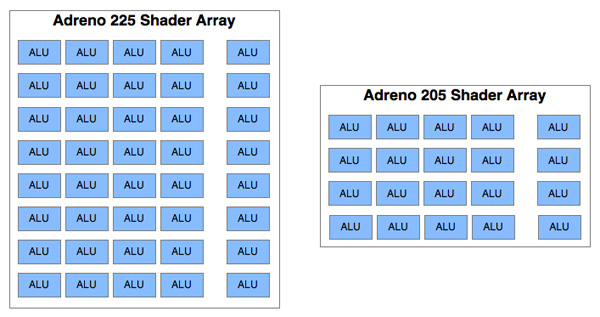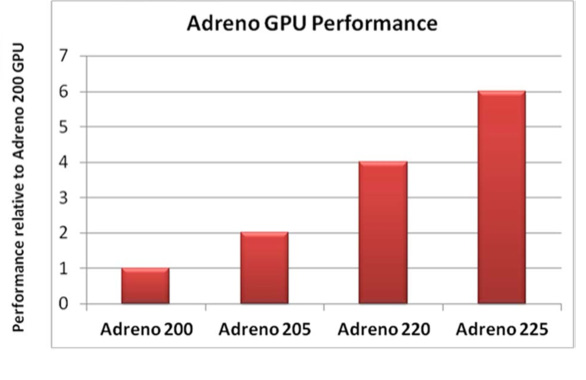Qualcomm's New Snapdragon S4: MSM8960 & Krait Architecture Explored
by Brian Klug & Anand Lal Shimpi on October 7, 2011 12:35 PM EST- Posted in
- Smartphones
- Snapdragon
- Arm
- Qualcomm
- Krait
- MDP
- Mobile
- SoCs
The Adreno 225 GPU
Qualcomm has historically been pretty silent about its GPU architectures. You'll notice that specific details of Adreno GPU execution resources have been absent from most of our SoC comparisons. Starting with MSM8960 however, this is starting to change.
The MSM8960 uses a current generation Adreno GPU with a couple of changes. Qualcomm calls this GPU the Adreno 225, a follow-on to Adreno 220. Subsequent Krait designs will use Adreno 3xx GPUs based on a brand new architecture.
As we discussed in our Samsung Galaxy S 2 review, Qualcomm's Adreno architecture is a tile based immediate mode renderer with early-z rejection. By Qualcomm's own admission, Adreno is somewhere in the middle of the rendering spectrum between IMRs and Imagination Technologies' TBDR architectures. One key difference is Adreno's tiling isn't as fine grained as IMG's.

Architecturally the Adreno 225 and 220 are identical. Adreno 2xx is a DX9-class unified shader design. There's a ton of compute on-board with eight 4-wide vector units and eight scalar units. Each 4-wide vector unit is capable of a maximum of 8 MADs per clock, while each scalar unit is similarly capable of 2 MADs per clock. That works out to 160 floating point operations per clock, or 32 GFLOPS at 200MHz.
Update: Qualcomm has clarified the capabilities of its 4-wide Vector ALUs. Similar to the PowerVR SGX 543, each 4-wide vector ALU is capable of four MADs (one per component). The scalar units cannot be combined to do any MADs, although they are helpful we haven't really been tracking those in this table (IMG has something similar) so we've excluded them for now.
| Mobile SoC GPU Comparison | |||||||||||
| Adreno 225 | PowerVR SGX 540 | PowerVR SGX 543 | PowerVR SGX 543MP2 | Mali-400 MP4 | GeForce ULP | Kal-El GeForce | |||||
| SIMD Name | - | USSE | USSE2 | USSE2 | Core | Core | Core | ||||
| # of SIMDs | 8 | 4 | 4 | 8 | 4 + 1 | 8 | 12 | ||||
| MADs per SIMD | 4 | 2 | 4 | 4 | 4 / 2 | 1 | ? | ||||
| Total MADs | 32 | 8 | 16 | 32 | 18 | 8 | ? | ||||
| GFLOPS @ 200MHz | 12.8 GFLOPS | 3.2 GFLOPS | 6.4 GFLOPS | 12.8 GFLOPS | 7.2 GFLOPS | 3.2 GFLOPS | ? | ||||
| GFLOPS @ 300MHz | 19.2 GFLOPS | 4.8 GFLOPS | 9.6 GFLOPS | 19.2 GFLOPS | 10.8 GFLOPS | 4.8 GFLOPS | ? | ||||
Looking at the table above you'll see that this is the same amount of computing power than even IMG's PowerVR SGX 543MP2. However as we've already seen in our tests, Adreno 220 isn't anywhere near as quick.
Shader compiler efficiency and data requirements to actually populate a Vec4+1 array are both unknowns, and I suspect both significantly gate overall Adreno performance. There's also the fact that the Adreno 22x family only has two TMUs compared to four in the 543MP2, limiting texturing performance. Combine that with the fact that most Adreno 220 GPUs have been designed into single-channel memory controller systems and you've got a recipe for tons of compute potential limited by other bottlenecks.
With Adreno 225 Qualcomm improves performance along two vectors, the first being clock speed. While Adreno 220 (used in the MSM8660) ran at 266MHz, Adreno 225 runs at 400MHz thanks to 28nm. Secondly, Qualcomm tells us Adreno 225 is accompanied by "significant driver improvements". Keeping in mind the sheer amount of compute potential of the Adreno 22x family, it only makes sense that driver improvements could unlock a lot of performance. Qualcomm expects the 225 to be 50% faster than the outgoing 220

Qualcomm claims that MSM8960 will be able to outperform Apple's A5 in GLBenchmark 2.x at qHD resolutions. We'll have to wait until we have shipping devices in hand to really put that claim to the test, but if true it's good news for Krait as the A5 continues to be the high end benchmark for mobile GPU performance.
While Adreno 225 is only Direct3D feature level 9_3 compliant, Qualcomm insisted that when the time is right it will have a D3D11 capable GPU using its own IP - putting to rest rumors of Qualcomm looking to license a third party GPU in order to be competitive in Windows 8 designs. Although Qualcomm committed to delivering D3D11 support, it didn't commit to a timeframe.










108 Comments
View All Comments
Zingam - Saturday, October 8, 2011 - link
And in that case you don't really need a tablet. Tablets would be very useful if they could deliver some kind of alternative user input and display. For instance: holographic displays (like in sci-fi movies) and voice control and input. That would actually make these mobile devices truly useful. The current generation and the coming generations would be nothing more than mobile browser and mp3/mp4 player.FunBunny2 - Saturday, October 8, 2011 - link
And, if it could work at all, how well would voice control work outside of an anechoic chamber (with a lone user talking to it)? But, I agree, tablets (used for decades in warehouses, by the way) will soft keyboards and the like are just a cheap and dirty way around the I/O issue.bjacobson - Saturday, October 8, 2011 - link
wow not sure what happened there.What I mean is we'll get a quad core phone with 4GB of RAM and all we'll need is a tablet to dock it to. The tablet will have the other connectivity options-- HDMI, USB, etc which will let the non-gamers replace their desktops and the people not needing Windows for business, replace their laptops.
dagamer34 - Saturday, October 8, 2011 - link
The dedicated gaming desktop will largely be obsolete in a few years. Games are much more GPU dependent than CPU dependent. What we will see is the era of external graphics cards which you can hook up to your laptop to play on your monitor @ 1080p with all the special effects turned up. Then you "undock" and rely on the integrated GPU to get longer battery life.Best of both worlds!
Death666Angel - Friday, October 7, 2011 - link
Thanks for the write up, pretty interesting stuff to come next year. Hopefully developers will embrace the new power, so that I can make fuller use of my Galaxy S2. I don't think I'll upgrade that soon though, pretty content with Galaxy S2 and it was expensive enough for now. I'll see what Christmas 2012 brings. :Dcnxsoft - Friday, October 7, 2011 - link
Back in February, Qualcomm also announced the quad-core Snapdragon APQ8064 would be ready in 2012. Any news on that ?HighTech4US - Friday, October 7, 2011 - link
Nvidia's roadmap clearly shows Kal-El+ as mid 2012 and 28nm Wayne at the end of 2012http://www.androidcentral.com/nvidias-tegra-roadma...
BoyBawang - Saturday, October 8, 2011 - link
Does it mean all Krait cores will be manufactured in LP like the Companion CPU of Kal-EL for energy efficiency that's why it won't go beyond 2ghz even at 28mm?skydrome1 - Saturday, October 8, 2011 - link
I know this article's on the Krait architecture, but in your comparison of the 2011/2012 SoC roadmap, I think you left out one very promising competitor: the ST Ericsson Nova A9600.Could this be included? And will there be any updates on this upcoming SoC?
On the whole, the 2012 roadmap looks really good. But I personally am looking forward to PowerVR's Series 6, the Cortex A15 MP and NVIDIA's Wayne the most.
Zingam - Saturday, October 8, 2011 - link
Hollyday season 2013